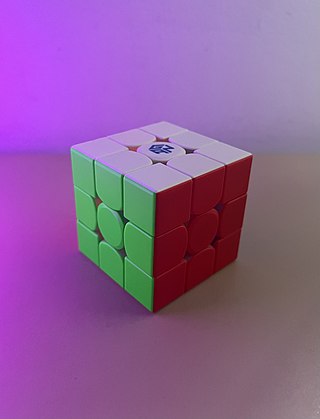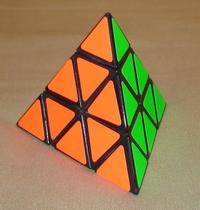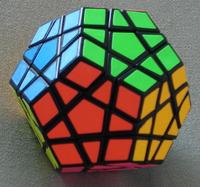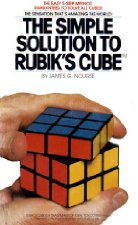Related Research Articles

The Rubik's Cube is a 3-D combination puzzle invented in 1974 by Hungarian sculptor and professor of architecture Ernő Rubik. Originally called the Magic Cube, the puzzle was licensed by Rubik to be sold by Pentangle Puzzles in the UK in 1978, and then by Ideal Toy Corp in 1980 via businessman Tibor Laczi and Seven Towns founder Tom Kremer. The cube was released internationally in 1980 and became one of the most recognized icons in popular culture. It won the 1980 German Game of the Year special award for Best Puzzle. As of March 2021, over 450 million cubes had been sold worldwide, making it the world's bestselling puzzle game and bestselling toy. The Rubik's Cube was inducted into the US National Toy Hall of Fame in 2014.

The Rubik's Revenge is a 4×4×4 version of the Rubik's Cube. It was released in 1981. Invented by Péter Sebestény, the cube was nearly called the Sebestény Cube until a somewhat last-minute decision changed the puzzle's name to attract fans of the original Rubik's Cube. Unlike the original puzzle, it has no fixed faces: the center faces are free to move to different positions.

Ernő Rubik is a Hungarian inventor. He is best-known for creating the Rubik's Cube (1974), Rubik's Magic, Rubik's Magic: Master Edition, and Rubik's Snake.

Optimal solutions for the Rubik's Cube are solutions that are the shortest in some sense. There are two common ways to measure the length of a solution. The first is to count the number of quarter turns. The second is to count the number of outer-layer twists, called "face turns". A move to turn an outer layer two quarter (90°) turns in the same direction would be counted as two moves in the quarter turn metric (QTM), but as one turn in the face metric.

Speedcubing, also referred to as speedsolving, is a competitive sport centered around the rapid solving of various combination puzzles. The most prominent puzzle in this category is the 3x3x3 puzzle, commonly known as the Rubik's Cube. Participants in this sport are known as "speedcubers," who focus specifically on solving these puzzles at high speeds, or more generally as "cubers". The essential aspect of solving these puzzles typically involves executing a series of predefined algorithms in a particular sequence.

The Professor's Cube is a 5×5×5 version of the original Rubik's Cube. It has qualities in common with both the 3×3×3 Rubik's Cube and the 4×4×4 Rubik's Revenge, and solution strategies for both can be applied.

The Pyraminx is a regular tetrahedron puzzle in the style of Rubik's Cube. It was made and patented by Uwe Mèffert after the original 3 layered Rubik's Cube by Ernő Rubik, and introduced by Tomy Toys of Japan in 1981.

David Breyer Singmaster was an American-British mathematician who was emeritus professor of mathematics at London South Bank University, England. He had a huge personal collection of mechanical puzzles and books of brain teasers. He was most famous for being an early adopter and enthusiastic promoter of the Rubik's Cube. His Notes on Rubik's "Magic Cube" which he began compiling in 1979 provided the first mathematical analysis of the Cube as well as providing one of the first published solutions. The book contained his cube notation which allowed the recording of Rubik's Cube moves, and which quickly became the standard.

The Megaminx or Mégaminx is a dodecahedron-shaped puzzle similar to the Rubik's Cube. It has a total of 50 movable pieces to rearrange, compared to the 20 movable pieces of the Rubik's Cube.
Lars Erik Petrus is an accomplished speedcuber. He has been described as a Rubik's Cube icon and master.
Jeffrey John (Jeff) Meckstroth is an American professional contract bridge player. He is a multiple world champion, winning the Bermuda Bowl on USA teams five times. He is one of only ten players who have won the so-called triple crown of bridge: the Bermuda Bowl, the World Open Pairs and the World Team Olympiad. As of May 16, 2016, he was the fifth-ranking World Grand Master. For decades Meckstroth has been in a regular partnership with Eric Rodwell and together, nicknamed "Meckwell", they are one of the most successful bridge partnerships of all time. They are well known for playing an aggressive and very detailed system that derived from Precision Club.
The CFOP method, also known as the Fridrich method, is one of the most commonly used methods in speedsolving a 3×3×3 Rubik's Cube and is one of the fastest methods. This method was first developed in the early 1980s, combining innovations by a number of speed cubers. Jessica Fridrich, a Czech speed cuber and the namesake of the method, is generally credited for popularizing it by publishing it online in 1997.
God's algorithm is a notion originating in discussions of ways to solve the Rubik's Cube puzzle, but which can also be applied to other combinatorial puzzles and mathematical games. It refers to any algorithm which produces a solution having the fewest possible moves. The allusion to the deity is based on the notion that an omniscient being would know an optimal step from any given configuration.

Kit Woolsey is an American bridge and backgammon player. He was inducted into the ACBL Hall of Fame in 2005.
Barry Crane was a prolific television producer and director, and a bridge player who, at the time of his death had "won more titles than anyone else in the history of the game". According to the American Contract Bridge League (ACBL), he was "widely recognized as the top matchpoint player of all time" —the tournament format commonly played in private clubs. In 1985 Crane was murdered, a crime that was not solved until 2021.
Robert "Bobby", "Bob" Goldman was an American bridge player, teacher and writer. He won three Bermuda Bowls, Olympiad Mixed Teams 1972, and 20 North American Bridge Championships. He authored books on bridge, most notably Aces Scientific and Winners and Losers at the Bridge Table, and conventions including Kickback, Exclusion Blackwood and Super Gerber (Redwood). He was from Highland Village, Texas.
Robert Glenn Etter is an American former professional football player who was a placekicker for four seasons in the National Football League (NFL) and World Football League (WFL) during the 1960s and 1970s. He played college football for the Georgia Bulldogs. He played professionally for the NFL's Atlanta Falcons in 1968 and 1969, and the Memphis Southmen of the WFL in 1974 and 1975.
The Red Ribbon Pairs national bridge championship is held annually at the Summer American Contract Bridge League (ACBL) North American Bridge Championship (NABC). Prior to the 2015 Summer NABC, the Red Ribbon Pairs event was held at the Spring NABC.

The Simple Solution to Rubik's Cube by James G. Nourse is a book that was published in 1981. The book explains how to solve the Rubik's Cube. The book became the best-selling book of 1981, selling 6,680,000 copies that year. It was the fastest-selling title in the 36-year history of Bantam Books.

Tony Fisher is a British puzzle designer who specialises in creating custom rotational puzzles. He is acknowledged by cubing enthusiasts as a pioneer in the creation of new puzzle designs and new manufacturing techniques. In 2017 the Guinness Book of World Records acknowledged Fisher as the creator of the world's largest Rubik's cube.
References
- ↑ First internet banking transaction
- 1 2 Slocum, Jerry (Autumn 1981). "Cubic Circular, Issue 1, p.12-13 'Shortest Times and Competitions'". Jaap's Puzzle Page. David Singmaster Ltd ⁄ 87 Rodenhurst Road ⁄ London, SW4 8AF ⁄ United Kingdom. ISSN 0261-8362. OCLC 811136353 . Retrieved 22 February 2024.
- ↑ Hofstadter, Douglas (June 1986). Metamagical Themas . New York: Bantam Books. p. 325. ISBN 0553342797. This book contains reprints from Hofstadter's Scientific American 1981–1983 articles.
- ↑ "Hot-Selling Hungarian Horror". TIME. Time Life. 23 March 1981. Archived from the original on 3 May 2011. Retrieved 17 February 2007.
- ↑ Slocum, Jerry (Summer 1985). "Cubic Circular, Issue 7&8, p.8 'More on the U Group'". Jaap's Puzzle Page. David Singmaster Ltd ⁄ 87 Rodenhurst Road ⁄ London, SW4 8AF ⁄ United Kingdom. ISSN 0261-8362. OCLC 811136353 . Retrieved 24 February 2024.[ clarification needed ]
- ↑ "Cubic Circular, Issue 1". Jaapsch.net. Retrieved 8 April 2015.
- ↑ Hammond, Nicolas (1981). How To Solve The Cube in 37 Secords. Derby, UK: DRG Blackhall. p. 19.
- ↑ Rubik's cube solution
- ↑ "ISS Extends ePatrol Managed Services – Launches Scanning Service to Deliver Remote Security Assessment Solutions" (Press release). Internet Security Systems. 27 September 1999. Archived from the original on 27 September 2007. Retrieved 18 February 2007.
- ↑ "Daily Bulletin" (PDF). 77–3 (3). 24 July 2005.
{{cite journal}}: Cite journal requires|journal=(help) - ↑ "Daily Bulletin" (PDF). ACBL Daily Bulletin. Vol. 78–9, no. 9. 22 July 2006.